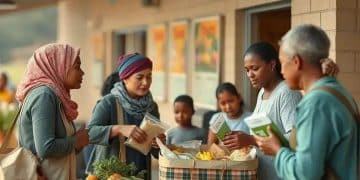Public health measures extended to combat flu season

Supporting vulnerable populations during flu season involves ensuring access to vaccinations, promoting hygiene practices, and providing education to reduce illness risk and protect public health effectively.
Public health measures extended to combat flu season can make a significant difference in our communities. Have you ever wondered how collective action might shield us from illnesses?
Understanding flu season and its impact
Understanding flu season is crucial for everyone. Each year, this seasonal virus can impact many lives, bringing about serious health risks. Knowing how the flu spreads and how to protect ourselves is the first step toward staying healthy during this time.
What is flu season?
Flu season typically occurs in the fall and winter months. During this time, the virus circulates more widely among the population. It’s important to recognize that the flu can spread easily, especially in crowded places.
How does flu spread?
The flu virus spreads mainly through droplets made when people cough, sneeze, or talk. You can also catch it by touching surfaces that have the virus on them, then touching your face.
- Stay away from sick individuals.
- Wash your hands regularly.
- Avoid touching your face, especially your eyes, nose, and mouth.
- Practice good respiratory hygiene.
During flu season, many people suffer from flu-related symptoms, including fever, body aches, and fatigue. This can lead to missed work and school days, affecting productivity for individuals and communities alike. Public health measures such as vaccination campaigns are important to combat these effects.
Getting vaccinated is one of the best ways to protect yourself. Vaccines are designed to provide immunity against prevalent strains of the virus each year. In addition to vaccination, public awareness campaigns can help educate communities on preventive measures.
Impact on vulnerable populations
Children, the elderly, and those with underlying health conditions are particularly at risk during flu season. It’s vital that we take steps to protect these groups, ensuring they receive their vaccinations and understand how to avoid infection.
By understanding flu season and its widespread impact, we can work together to minimize risks and enhance community health. Everyone plays a part in preventing the flu.
The role of vaccination in public health

The role of vaccination in public health is vital to maintaining community health. Vaccines protect millions, preventing diseases that could otherwise lead to severe illness or even death.
How vaccines work
Vaccines train the immune system to recognize and fight specific pathogens. When vaccinated, a person’s body learns how to respond effectively if exposed to the real virus in the future.
- Vaccines stimulate the immune response.
- They can prevent serious diseases like the flu.
- Herd immunity protects those who can’t be vaccinated.
- Vaccination reduces healthcare costs.
During flu season, public health campaigns highlight the importance of getting the flu vaccine. These campaigns educate communities on the benefits and encourage participation. When a high percentage of the population is vaccinated, it creates a shield that helps prevent outbreaks.
Many people may wonder why vaccination is necessary. Vaccines help reduce the risk of severe outcomes, hospitalizations, and deaths related to the flu. They also help in easing the burden on healthcare systems, particularly during peak seasons when hospitals are overwhelmed.
Community benefits of vaccination
Vaccination leads to healthier communities. When most people are vaccinated, those who are vulnerable, like infants and older adults, are less likely to catch the flu.
Additionally, some people cannot receive vaccines due to medical conditions. Vaccination protects them through herd immunity. The more people who are immunized, the safer it is for everyone. Remember, by getting vaccinated, you are not just protecting yourself but also those around you.
Community measures to prevent flu outbreaks
Community measures to prevent flu outbreaks are essential during flu season. Taking action together can significantly reduce the spread of the virus and protect vulnerable populations.
Importance of awareness
Raising awareness in the community is the first step. Educating people on flu symptoms, prevention methods, and the importance of vaccination can lead to better public health outcomes. When people know how the flu spreads, they’re more likely to take precautions.
- Share information about flu symptoms.
- Encourage vaccination through community programs.
- Promote good hygiene practices.
- Organize health fairs to provide flu shots.
Furthermore, community leaders can play a significant role in promoting flu prevention measures. Their influence can help spread the message of safety and health to a wider audience.
Practicing good hygiene
Practicing good hygiene is a crucial part of preventing flu outbreaks. Simple actions can make a big difference. Washing hands frequently, using hand sanitizer, and covering sneezes and coughs can help reduce transmission rates.
Additionally, public spaces should provide easy access to hand sanitizers. Schools, workplaces, and community centers should promote cleanliness. Maintaining clean environments helps protect everyone, especially vulnerable groups like the elderly and young children.
Lastly, suggesting that sick individuals stay home is important. This reduces the risk of spreading the virus to others. Encouraging businesses and schools to be flexible with sick leave can encourage people to prioritize their health.
How to support vulnerable populations during flu season

Supporting vulnerable populations during flu season is essential for public health. These groups, including the elderly, young children, and individuals with chronic health conditions, are at a higher risk for severe illness.
Identify at-risk groups
First, it is crucial to identify who is considered vulnerable. Understanding these populations can help tailor support effectively. Some of the at-risk groups include:
- Older adults over 65 years.
- Children under 5 years.
- Pregnant women.
- Individuals with chronic diseases such as asthma or diabetes.
Once these groups are identified, the next step is to implement supportive measures. This can involve outreach programs that provide information on flu prevention.
Access to vaccinations
Ensuring that vulnerable populations have easy access to flu vaccinations is vital. Mobile clinics can be organized in community centers or even at home for those who cannot travel. It’s important to work with local health departments to arrange these services.
Additionally, offering vaccinations at no cost can encourage participation. Many people in vulnerable populations may lack the resources to pay for healthcare and vaccines. Providing these services removes barriers to access.
Furthermore, educational materials are valuable in helping individuals understand the importance of vaccination. When people know how vaccines work and their benefits, they are more likely to get vaccinated.
Promoting health education
Education also plays a crucial role in supporting vulnerable groups during flu season. Community health programs can offer workshops that teach proper hygiene practices. Key information can include:
- The importance of handwashing.
- How to recognize flu symptoms.
- When to seek medical help.
- How to care for someone with the flu.
By promoting hygiene education, members of the community can better protect themselves and their loved ones.
Lastly, building a support network can be beneficial. Neighbors, family, and friends can check on vulnerable individuals during flu season. Providing assistance with grocery shopping or transportation to medical appointments can make a significant difference.
FAQ – Supporting Vulnerable Populations During Flu Season
Why is it important to support vulnerable populations during flu season?
Supporting vulnerable populations helps prevent severe illnesses and reduces the overall impact of the flu in the community.
What can communities do to help protect vulnerable groups from the flu?
Communities can offer flu vaccinations, provide health education, and promote good hygiene practices.
How can I help my elderly neighbors during flu season?
You can check on them regularly, help with grocery shopping, and encourage them to get vaccinated.
What should vulnerable individuals know about flu prevention?
Vulnerable individuals should understand the importance of vaccination, recognize flu symptoms, and practice good hygiene to reduce infection risks.





